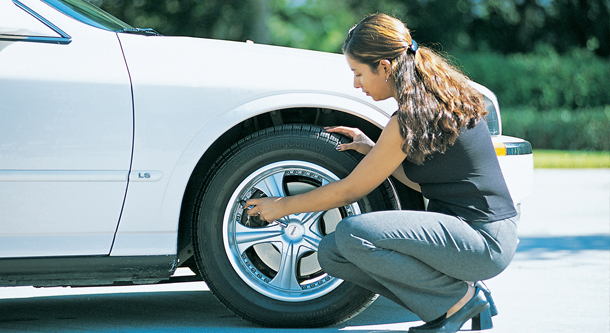
WASHINGTON, D.C. (October 23, 2023)—A new study by AAA found that in-vehicle tire pressure monitoring systems (TPMS) are generally accurate, but drivers should still check their tire pressure manually. Why keep tabs on your tires? They are the only part of your car in contact with the road, and proper inflation is the key to safety and better gas mileage.
“Whether in rain, sleet, snow, or dry conditions, tires are the unsung heroes of your car,” said Greg Brannon, AAA’s director of automotive engineering. “They are designed to work best when properly inflated. Our research found that the pressure monitoring systems that provide data for instrument displays or trigger the amber dashboard warning worked as intended. But we recommend always having a dependable old-school manual pressure gauge to check them once a month because a tire can be more than 20% deflated before it triggers the dashboard warning.”
AAA engineers evaluated 11 passenger vehicles, 2022-2024 models including sedans, pickups, and SUVs, with “direct” TPMS, which uses air pressure sensors mounted in each wheel. According to the AAA study, the average percentage difference between displayed and actual tire pressure was between 1.2% and -1.5%, depending on tire location. Additionally, the amber warning TPMS light illuminated when tires were underinflated to 75% of the posted pressure (located on the sticker inside the door jam) for five of eleven test vehicles. Five of the six remaining test vehicles illuminated the TPMS warning dashboard light when tires were deflated to 70.3 to 72.9% of posted pressure, depending on the test vehicle.
Key findings from the study:
- No significant error in displayed tire pressure readings was noted for any vehicles evaluated within the study.
- The largest percentage difference in reported vs. actual tire pressure was 3.3% percent. This large pickup truck had a significantly higher posted pressure than other test vehicles.
- One vehicle did not illuminate the TPMS warning light even when one of its tires was deflated to only 65% of the recommended posted pressure, despite the immediate update of pressure readings in the instrument cluster.
AAA’s recommendations:
AAA urges drivers to utilize displayed tire pressures in the instrument cluster and keep tires inflated to the vehicle’s posted pressure rather than relying solely on the TPMS light to determine when a tire needs to be re-inflated. TPMS lights only illuminate when one or more tires are severely underinflated, so drivers should regularly check the displayed tire pressure at each corner. In addition, not all vehicle TPMS systems provide pressure readings. Some systems, especially on older vehicles, only have a warning light if one or more tires are low.
AAA encourages drivers to regularly check their tire pressure (either in the instrument cluster or using a gauge), even if their TPMS light is not illuminated. And with winter approaching, it’s important to remember that cold weather makes the air denser, so the pressure in the tire is reduced, triggering a dashboard warning. Do not ignore the warning even if the light goes off after driving because the tire is likely low. For this reason, tire pressure should be checked when cold.
Please refer to the full report for methodology details – including specific vehicle makes/models, tire brands and specifications, and testing equipment.
About AAA
Started in 1902 by automotive enthusiasts who wanted to chart a path for better roads in America and advocate for safe mobility, AAA has transformed into one of North America’s largest membership organizations. Today, AAA provides roadside assistance, travel, discounts, and financial and insurance services to enhance the life journey of over 64 million members across North America, including over 56 million in the United States. To learn more about all AAA offers or become a member, visit AAA.com.
